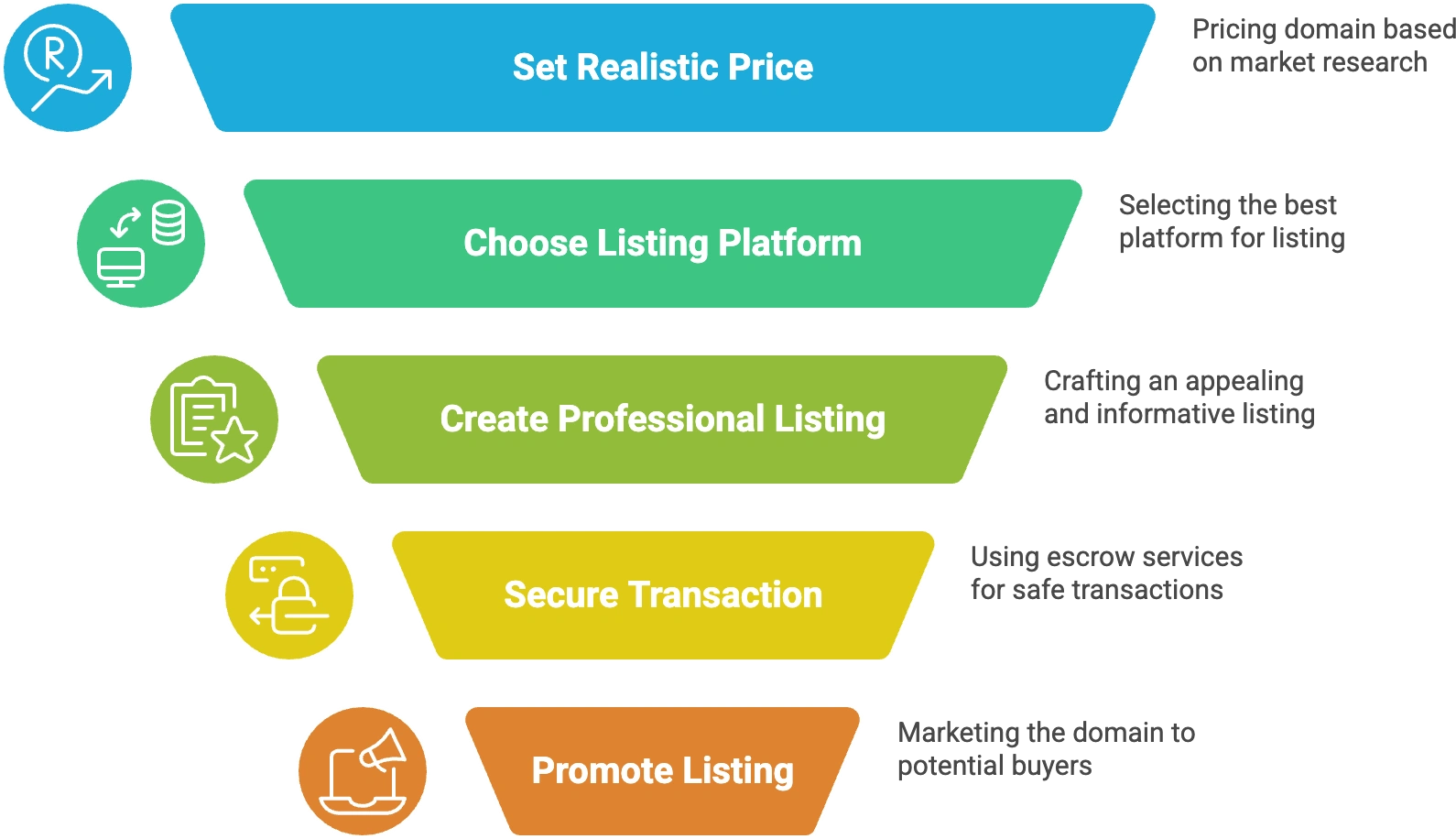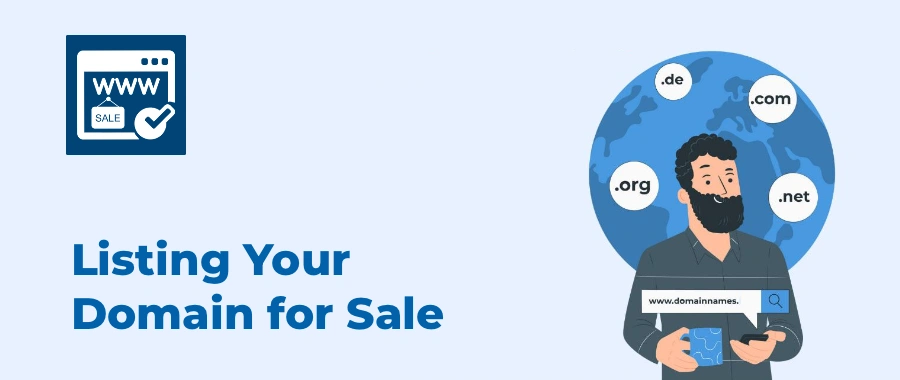Listing your domain for sale the right way can make or break the deal. A sloppy or incomplete listing may drive away serious buyers, while a professional and well-prepared listing builds trust and attracts better offers. A sloppy or incomplete listing may drive away serious buyers, while a professional and well-prepared listing builds trust and attracts better offers.
Many beginners rush through the process — throwing their domain on a random marketplace with little thought. The result? Lowball offers, missed opportunities, and domains that sit unsold for months.
In this guide, we’ll walk you through a step-by-step framework for listing your domain for sale the right way. From preparation and pricing to creating a professional listing and securing the transaction, you’ll learn exactly how to set yourself up for a faster, more profitable sale in 2025.
Table of Contents

Step 1 – Prepare Your Domain Before Listing for Sale
Before you can successfully list your domain, you need to make sure it’s ready for buyers. Think of this as cleaning up a house before putting it on the market — presentation and readiness matter.
First, check the status of your domain. Ensure it’s not locked, has no pending transfers, and is available for an easy ownership change. Buyers want reassurance that the domain can be transferred without delays.
Next, confirm your WHOIS information is up-to-date. Accurate contact details not only make your listing more trustworthy but also help potential buyers or marketplaces verify ownership quickly.
If your domain is still connected to an old website or holding outdated content, take the time to clear it out. A clean domain looks more professional and avoids confusion about what’s actually for sale.
💡 Bonus Tip: Short, memorable, and keyword-rich domains sell much faster. If you already own a clean name with no extra characters or hyphens, you’ve got a stronger chance of attracting premium offers.
Step 2 – Set a Realistic Price Before Listing Your Domain for Sale
One of the biggest mistakes domain sellers make is overpricing their domains. While it’s tempting to set a high figure, unrealistic pricing can instantly scare off potential buyers and leave your domain sitting unsold for months — or even years.
Start by researching comparable sales. Sites like NameBio, Sedo, and GoDaddy Auctions allow you to see what similar domains have sold for in the past. This gives you a baseline to understand market demand and set expectations.
Next, decide how you want to structure your listing:
- Fixed Price: Buyers see the price upfront and can purchase immediately. This works well for lower to mid-value domains.
- Make Offer: Gives buyers the chance to submit bids. This is often better for premium or highly brandable domains, as it opens the door to negotiation.
You can also use online valuation tools such as Estibot or GoDaddy Appraisal to get a quick estimate of your domain’s worth. However, take these numbers with a grain of salt — they’re automated and don’t account for brand potential, trends, or niche demand.
Remember: buyers compare your domain to others. If your asking price is far above the market range without clear justification, most buyers will simply move on. A realistic, well-researched price signals that you’re serious and increases the chances of closing a deal.
Step 3 – Choose Where to List Your Domain for Sale
Once your domain is ready and priced correctly, the next step is choosing where to list your domain for sale. Picking the right platform is crucial because it determines how much visibility your listing gets and what kind of buyers you’ll attract.
Here are the main options:
1. Marketplaces: Popular platforms like Sedo, Afternic, Flippa, and GoDaddy Auctions give your domain exposure to thousands of potential buyers. They’re beginner-friendly, but they charge commissions on successful sales.
2. Domain Brokers: If you own a premium domain, working with a broker can help you get the best deal. Brokers actively reach out to potential buyers, negotiate on your behalf, and typically charge higher fees — but they can unlock serious offers.
3. Private Sale via Your Own Site: For maximum control and zero commission fees, you can list your domain on your own website. Tools like the Domain For Sale WordPress Plugin make it easy to create customizable sales pages, capture offers, and manage everything inside WordPress.
💡 Pro Tip: Many sellers use a combination — they list their domains on marketplaces for visibility while also running private listings to capture direct offers.
Step 4 – Create a Professional Listing
Now that you’ve chosen your platform, it’s time to actually create the listing for your domain for sale. A polished, professional listing doesn’t just make your domain look more valuable — it builds trust and convinces buyers to take action.
Start with a clear headline that highlights the domain name itself. Keep it simple — the domain is the product, so put it front and center.
Next, write a short description explaining why the domain is valuable. Mention possible uses, industries, or niches it fits into, and include any strong keywords the domain contains.
Be upfront about your pricing model. Whether you’ve set a fixed price or enabled a “Make an Offer” option, transparency helps filter out unqualified buyers. Pair this with a built-in form where buyers can quickly submit bids or inquiries.
Don’t forget to add a strong call-to-action (CTA) like “Buy Now,” “Submit an Offer,” or “Inquire Today.” CTAs encourage buyers to move forward instead of clicking away.
If your domain was previously tied to a website, consider adding screenshots of archived versions (via tools like Wayback Machine). This can demonstrate past authority or traffic relevance, making the name even more attractive.
Step 5 – Secure the Transaction
When it comes to closing the deal, security is everything. The safest way to handle payment and transfer when listing your domain for sale is to always use escrow services. Trusted providers like Escrow.com, Dan.com, or GoDaddy Escrow ensure that both buyer and seller are fully protected.
Here’s how the process works in simple terms:
- The buyer submits payment to the escrow service.
- The escrow company holds the funds securely while the domain transfer takes place.
- Once you’ve transferred the domain to the buyer, the escrow service confirms completion.
- The escrow releases the funds directly to you.
This setup gives buyers peace of mind that their money is safe until the domain is in their account, while protecting you from fraud or bounced payments.
💡 Pro Tip: Never agree to direct PayPal or wire transfers with strangers. Using escrow not only keeps the transaction secure but also shows buyers that you’re a professional seller they can trust.
Step 6 – Promote Your Domain Listing
Creating a listing is only half the job — now you need to get it in front of potential buyers. Many sellers overlook promotion, but it’s one of the most important steps in listing your domain for sale successfully.
Start by sharing your listing on social media platforms like LinkedIn, Twitter/X, and niche communities where entrepreneurs, startups, and digital marketers gather. A single post in the right place can spark serious buyer interest.
For higher-value domains, consider direct outreach. Research startups or companies that could benefit from your domain name and send a short, professional message letting them know the domain is available. Personalized outreach often works better than waiting passively for offers.
Finally, if you want to capture leads directly, add a “Domain For Sale” page right on the domain itself. With the Domain For Sale WordPress Plugin, you can instantly create a professional landing page with forms and offers management — giving buyers a quick and easy way to contact you.
By actively promoting your domain across multiple channels, you increase visibility, attract qualified buyers, and shorten the time it takes to close the sale.
Step 7 – Monitor & Follow Up
Once you’ve finished listing your domain for sale, the work doesn’t stop there. The key to converting interest into an actual sale is consistent monitoring and timely follow-up.
Keep track of all inquiries and offers that come in. Pay attention to who showed serious interest, how much they offered, and any messages they included. This information helps you prioritize follow-ups with genuine buyers.
If a buyer goes silent after showing interest, send a polite follow-up email. Sometimes people get busy, forget, or want a little nudge before making a decision. A professional reminder can often reopen the conversation.
Finally, if you’re not seeing much traction after weeks or months, consider adjusting your price, description, or listing strategy. Markets shift, and staying flexible ensures your domain remains attractive to buyers.
Remember: successful sellers don’t just create a listing — they manage it actively until the deal is done.
FAQs About Listing Your Domain for Sale
What is the best place for listing your domain for sale?
You can use marketplaces like Sedo, Afternic, or Flippa for exposure, or create your own professional listing with the Domain For Sale plugin for more control and zero commissions.
How do I set the right price when listing my domain for sale?
Research comparable sales, use appraisal tools as a guideline, and stay realistic. Overpricing can push away buyers.
Is escrow required when selling a domain?
Yes — escrow services like Escrow.com or Dan.com protect both buyer and seller by holding funds securely until the domain transfer is complete.
Can I sell multiple domains at once?
Yes. You can list domains individually or bundle them together. Tools like the Domain For Sale plugin make it easy to manage multiple listings directly from WordPress.
How long does it take to sell a domain after listing it for sale?
It depends on the quality of the domain, pricing, and promotion. Some domains sell in days, while others may take months. Active promotion and follow-ups can speed up the process.
Conclusion
Selling a domain doesn’t have to be complicated — it’s all about following the right process. From preparing your domain and setting a realistic price, to choosing the best marketplace, listing your domain for sale professionally, securing the deal with escrow, promoting your listing, and following up — each step builds toward a smooth, successful transaction.
Many beginners rush in and miss opportunities, but when you take the time to do things properly, you’ll find that listing your domain for sale the right way can be simple and highly rewarding.
Want the fastest way to list your domains professionally?
Try the Domain For Sale WordPress Plugin and create optimized listings with built-in offer management in just minutes.

Leave a Reply